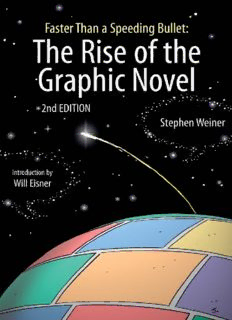
Faster than a speeding bullet : the rise of the graphic novel PDF
Preview Faster than a speeding bullet : the rise of the graphic novel
ISBN 978-1-56163-702-7 Library of Congress Control Number: 2012947465 Faster than a Speeding Bullet: The Rise of the Graphic Novel ©2003 Stephen Weiner © 2012 Stephen Weiner for the second edition updates Covers and artwork © their respective owners Editor: N. C. Christopher Couch, except for updates Foreword ©2003 Will Eisner Cover art ©2003 Jeff Smith Cover coloring by Steve Hamaker Book Design by Chris Shadoian For Ken, my brother 1949-2002 & for Bill Sleator 1945-2011 Contents Foreword by Will Eisner Preface 1. The First Comics: Americans Embrace a New Art Form 2. The 1950s: The Shadow of McCarthyism 3. The 1960s: Troubled Heroes for Troubled Times 4. The Comic Book Store: Fans Find a Home 5. The Graphic Novel: Comics Take Themselves Seriously 6. Trade Publishers and Comics: An Uneasy Alliance 7. Opening the Gates: The Comics Field Grows 8. The New Heroes: Would You Let this Man Marry Your Sister? 9. Maus: Surviving and Thriving 10. The Sandman: A New Mythology 11. Bone Wars: The Paradigm Shifts into High Gear 12. Understanding Comics: The Dream of a Common Language 13. A Message in a Bottle: Notes from the Underground 14. A New Millennium For Comics 15. What’s Next for Graphic Novels Further Reading Foreword Will Eisner At the very moment in its history when the lowly comic book has at long last reached maturity it is important to have this excellent account of its journey from “literary fast food” to acceptable popular literature. My applause for this work stems from my long and often frustrating involvement with comics as a medium. When I entered the profession—I was present at its birth—comic books, which were then called magazines, were dismissed as cheap entertainment for kids. They were disdained by the arbiters of our culture. I myself had only a visceral belief in the viability of the art or its future as acceptable literature. There was no evidence of its endurance as anything other than a fleeting fad of popular culture. History has proved otherwise. At this writing almost seventy years later, comic book publishing thrives, providing opportunity for young creators and a body of popular literature firmly built on its own picture-story language. Available to readers now are a variety of categories from simple, thirty-two-page adventure, horror, superhero, instructional, reportage, and experimental comics and Japanese manga to the weighty graphic novels. The manner of their creation has evolved from a work written and drawn by a single individual to a wedding between writer and artist. This has established a creative process that employs the skills of an accomplished writer and an artist of great sophistication. All of which has attracted critical approval and elevated the standards of the medium. Superhero comics are mined by the motion picture industry for ideas, plots, and audiences. Motion picture adaptation of comics is now widespread. Japanese manga, with their animation-related artwork, are finding a huge following among American teenage readers. Meanwhile, establishment bookstores are assigning shelf space for Pulitzer Prize and other award winners as well as serious graphic novels that address adults. The most significant evidence of comics’ arrival, however, is their acceptance and acknowledgment by public librarians. The inclusion of graphic novels in their collections is a most welcome happening and, I might say, about time. It was the converging of our interest in this awakening that provided me with an opportunity to exchange with Steve an observation of the current movement by the tectonic plates of our literary world and introduced me to this work. Steve Weiner has produced a very responsible survey and introduction to this literary phenomenon. Read it, learn, and enjoy.
Description: